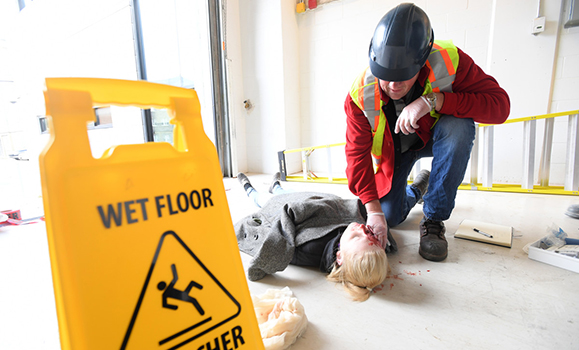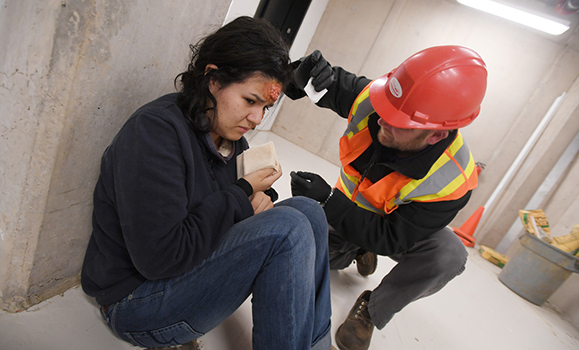Editor's note: The following story contains photographs of mock accident scenes with make-up effects, including fake blood.
The blood-curdling screams ripped through the unseasonably warm Thursday morning air, as passersby on LeMarchant Street stopped to catch a glimpse at what had transpired at Dalâs Mona Campbell Building.
Inside the open loading bay, a young woman was lying on the cold concrete floor, covered in blood. A ladder was on the ground beside her. Did she fall? Was she struck? As she clutched her face, a crew of first responders tended to her while awaiting an ambulance, at the same time starting to take steps to figure what the heck had just happened.
Incredibly, herâs werenât the only screams in the Mona Campbell Building that morning. Almost at the exact same time, another group of responders arrived in the buildingâs basement to the scene of what appeared to be some sort of chemical burn. A custodian shrieked as her supervisor tended to her scarred, inflamed face, panicking over what to do as the rest of the accident investigation team arrived on the scene.
Thankfully, the gory bits were just makeup, and the âvictims,â âsupervisorsâ and âwitnessesâ just actors: students from Dalâs Fountain School of Performing Arts, in fact, who were helping bring the simulation to life. The responders were students themselves, from the College of Continuing Education, completing their âfinal examinationâ in the advanced-level Accident Investigation course.
 Student actor Meg Fenchak is tended to after her "accident." Ìę
Student actor Meg Fenchak is tended to after her "accident." Ìę
Solving the puzzle
Part of the College of Continuing Educationâs Occupational Health and Safety (OHS) Management certificate program, the four-day Accident Investigation course is typically taken by professionals working in the field, exposing them to the background, understanding and methods needed to conduct a thorough and effective investigation of a workplace accident.
âIf you donât dig down to the root cause of an accident, then you canât stop it from happening again,â said Vince Garnier, the courseâs instructor. âSo we teach a lot of accident theory before transitioning to investigation methodology: how to approach a scene, caring for the injured worker, understanding what is evidence and what is not.â
Garnier has more than 34 years of experience in the field, covering both law enforcement and OHS public policy and regulatory enforcement. Heâs hired by the College of Continuing Education to teach the Accident Investigation course, typically offered twice a year.
âItâs almost like a puzzle,â says Garnier, pointing around to some of the various pieces of evidence in the loading bay scenario. âYou have a 500-piece puzzle: you have to find all the pieces, put them together, and then you have the full picture.â
Downstairs, outside the bathroom where the chemical burn scenario was underway, Steve Job was monitoring the cordoned-off scene. A student in the Accident Investigation course, heâs nearing the end of a career in the military and looking to get into OHS work. This is the last course needed to complete his OHS Management certificate.
âYou learn a lot,â he said, highlighting the simulation, in particular, as a valuable part of the experience. âDoing a realistic situation causes people to react differently to things, makes it more real.â
A unique student experience
âMore realâ is exactly what the student actors from the Fountain School are striving for in each of the two scenarios. Their performances are not scripted: theyâre given a bit of background about their character, and some guidelines on how to react to the response team (one victim, for example, is to be particularly difficult to work with), but moment-by-moment, theyâre improvising.
âWe recently did a lot of improv workshopping [in class], so it was very interesting to try and incorporate everything weâve been learning lately about acting without a complete script,â said Meg Fenchak, a third-year student who portrayed the loading bay victim.

Claudia Gutierrez-Perez, burn victim, gets examined while waiting for the "ambulance" to arrive.
For Claudia Gutierrez-Perez, a fellow third-year student who took on the role of the burn victim, this was her second time taking part in the exercise; she enjoyed it so much last time the course was taught, she signed up for a return engagement.
âItâs really fun,â she said. âItâs about being honest to what youâd be going through in that exact experience, putting yourself in their shoes.â
âItâs a good acting experience to see the full range of the work you can do,â adds Jonah Campbell, also a third-year student. âNot all acting has to be on a stage at a theatre; you can do things like this, too.â
The performances (for which the students are paid) donât end at the accident site: after their âwoundsâ are tended to, the actors sit down for forensic interviews, answering questions to help the courseâs students complete their final reports outlining what happened. Itâs one more way the student actors help make the experience come alive.
âTheyâre the ones who help make this real,â says Garnier. âYou can sit for several days in class and do theory, but 90 per cent of what people learn is from doing. It has to feel real. Our students, in their course evaluations, always come back and say, âThat was the best part of the whole thing. I wonât forget this stuff.ââ

